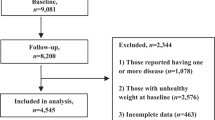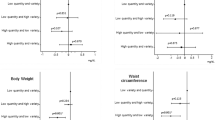Abstract
Background/objectives:
Healthy eating behaviours, such as increasing fruit and vegetable consumption (FVC), are frequently used as a target or outcome measure in obesity prevention interventions. The goal of this study was to demonstrate replacement of high-caloric foods/drinks by FVC and changes in body mass index (BMI) z-score associated with FVC.
Subjects/methods:
Anthropometric measurements of 1252 children (51.0% girls) were taken before school entrance (age 6 years) and repeated in the fourth grade (age 10 years). At the same time, parents were asked about their children’s diet using a questionnaire.
Results:
In longitudinal analysis, changes in FVC were not significantly correlated with changes of other nutritional habits, such as consumption of sweets and high-caloric drinks. BMI gain tended to be lower (nonsignificant) in children with increasing fruit consumption compared to those with decreasing fruit consumption. An opposite (nonsignificant) tendency was observed for vegetable consumption and BMI gain.
Conclusions:
Although beneficial for other health outcomes, the evidence for FVC replacing high-energy foods and thereby reducing BMI gain is weak and could not be substantiated in this study. This might be partially due to the limitation in dietary assessment.
This is a preview of subscription content, access via your institution
Access options
Subscribe to this journal
Receive 12 print issues and online access
$259.00 per year
only $21.58 per issue
Buy this article
- Purchase on Springer Link
- Instant access to full article PDF
Prices may be subject to local taxes which are calculated during checkout

Similar content being viewed by others
References
WHO. Diet, nutrition and the prevention of chronic diseases: report of a joint WHO/FAO expert consultation. World Health Organization: Geneva, 2003, Report no. 916. Available from: http://www.who.int/dietphysicalactivity/publications/trs916/download/en/index.html.
Hermsdorff HHM, Barbosa KBF, Volp ACP, Puchau B, Bressan J, Zulet MÁ et al. Vitamin C and fibre consumption from fruits and vegetables improves oxidative stress markers in healthy young adults. Br J Nutr 2012; 107: 1119–1127.
Jansen RJ, Robinson DP, Stolzenberg-Solomon RZ, Bamlet WR, de Andrade M, Oberg AL et al. Fruit and vegetable consumption is inversely associated with having pancreatic cancer. Cancer Causes Control 2011; 22: 1613–1625.
Hardin J, Cheng I, Witte JS . Impact of consumption of vegetable, fruit, grain, and high glycemic index foods on aggressive prostate cancer risk. Nutr Cancer 2011; 63: 860–872.
Abi Haidar G, Lahham Salameh N, Afifi RA . Jarrib Baleha — a pilot nutrition intervention to increase water intake and decrease soft drink consumption among school children in Beirut. J Med Liban 2011; 59: 55–64.
Vereecken C, Huybrechts I, van Houte H, Martens V, Wittebroodt I, Maes L . Results from a dietary intervention study in preschools “Beastly Healthy at School”. Int J Public Health 2009; 54: 142–149.
Anderson AS, Porteous LEG, Foster E, Higgins C, Stead M, Hetherington M et al. The impact of a school-based nutrition education intervention on dietary intake and cognitive and attitudinal variables relating to fruits and vegetables. Public Health Nutr 2005; 8: 650–656.
Epstein LH, Gordy CC, Raynor HA, Beddome M, Kilanowski CK, Paluch R . Increasing fruit and vegetable intake and decreasing fat and sugar intake in families at risk for childhood obesity. Obes Res 2001; 9: 171–178.
Vioque J, Weinbrenner T, Castelló A, Asensio L, Garcia de la Hera M . Intake of fruits and vegetables in relation to 10-year weight gain among Spanish adults. Obesity (Silver Spring) 2008; 16: 664–670.
Ledoux TA, Hingle MD, Baranowski T . Relationship of fruit and vegetable intake with adiposity: a systematic review. Obes Rev 2011; 12: e143–e150.
Taylor RW, McAuley KA, Barbezat W, Strong A, Williams SM, Mann JI . APPLE Project: 2-y findings of a community-based obesity prevention program in primary school–age children. Am J Clin Nutr 2007; 86: 735.
Bayer O, von Kries R, Strauss A, Mitschek C, Toschke AM, Hose A et al. Short- and mid-term effects of a setting based prevention program to reduce obesity risk factors in children: a cluster-randomized trial. Clin Nutr 2009; 28: 122–128.
de Sa J, Lock K . Will European agricultural policy for school fruit and vegetables improve public health? A review of school fruit and vegetable programmes. Eur J Public Health 2008; 18: 558–568.
Von Kries R, Beyerlein A, Müller MJ, Heinrich J, Landsberg B, Bolte G et al. Different age-specific incidence and remission rates in pre-school and primary school suggest need for targeted obesity prevention in childhood. Int J Obes (Lond) 2012; 36: 505–510.
Bolte G, Heissenhuber A, von Kries R, Liebl B, Zapf A, Wildner M et al. [Health monitoring units in Bavaria. Concept, aims and thematic focus of the first survey on children’s environment and health]. Bundesgesundheitsblatt Gesundheitsforschung Gesundheitsschutz 2007; 50: 476–483.
Twardella D, Bolte G, Fromme H, Wildner M, von Kries R . Exposure to secondhand tobacco smoke and child behaviour — results from a cross-sectional study among preschool children in Bavaria. Acta Paediatr 2010; 99: 106–111.
WHO. BMI-for-age. 2007 (cited 16 June 2009). Available from http://www.who.int/growthref/who2007_bmi_for_age/en/index.html.
Bayer O, Bolte G, Morlock G, Rueckinger S, von Kries R, Grp G-S . A simple assessment of physical activity is associated with obesity and motor fitness in pre-school children. Public Health Nutr 2009; 12: 1242–1247., Corrigendum 1308.
Bayer O, Jarczok M, Fischer J, von Kries R, De Bock F . Validation and extension of a simple questionnaire to assess physical activity in pre-school children. Public Health Nutr 2012; 15: 1611–1619.
James J, Thomas P, Cavan D, Kerr D . Preventing childhood obesity by reducing consumption of carbonated drinks: cluster randomised controlled trial. BMJ 2004; 328: 1237.
Bere E, Veierød MB, Klepp K-I . The Norwegian School Fruit Programme: evaluating paid vs no-cost subscriptions. Prev Med 2005; 41: 463–470.
Roumelioti M, Leotsinidis M . Relative validity of a semiquantitative food frequency questionnaire designed for schoolchildren in western Greece. Nutr J 2009; 8: 8.
Burrows TL, Martin RJ, Collins CE . A systematic review of the validity of dietary assessment methods in children when compared with the method of doubly labeled water. J Am Diet Assoc 2010; 110: 1501–1510.
Lüdtke O, Tomasik MJ, Lang FR . Teilnahmewahrscheinlichkeit und Stichprobenselektivität in altersvergleichenden Erhebungen. Zeitschrift für Entwicklungspsychologie und Pädagogische Psychologie 2003; 35: 171–180.
Acknowledgements
We thank the study Group of the GME cohort. This study was supported by Bavarian Health and Food Safety Authority, Munich (Gabriele Bolte, Hermann Fromme, Lana Hendrowarsito and Nicole Meyer); Health Authority of the District Office of Günzburg (Tatjana Frieß-Hesse, Franziska Lang, Roland Schmid and Gudrun Winter); Health Authority of the City Ingolstadt (Christine Gampenrieder, Margot Motzet, Elisabeth Schneider, Traudl Tontsch and Gerlinde Woelk); Institute of Social Paediatrics and Adolescent Medicine, Ludwig-Maximilians University of Munich (Ladan Baghi, Otmar Bayer and Rüdiger von Kries). This study was funded by the health initiative ‘Gesund.Leben.Bayern.’ of the Bavarian State Ministry of the Environment and Public Health, Munich, Germany. OB is supported by LMUinnovativ research priority project MCHealth (subproject II).
Author information
Authors and Affiliations
Consortia
Corresponding author
Ethics declarations
Competing interests
The authors declare no conflict of interest.
Additional information
Contributors: OB, MD, epidemiologist, designed the study, did the statistical analysis and wrote the paper; IN, nutritionist, reviewed the literature and wrote the paper; GB, epidemiologist, provided data set and revised the paper; RvK, Professor of Paediatric Epidemiology, revised the paper and obtained funding that made the scientific work (analysis, writing and revision of paper) possible.
Rights and permissions
About this article
Cite this article
Bayer, O., Nehring, I., Bolte, G. et al. Fruit and vegetable consumption and BMI change in primary school-age children: a cohort study. Eur J Clin Nutr 68, 265–270 (2014). https://doi.org/10.1038/ejcn.2013.139
Received:
Revised:
Accepted:
Published:
Issue Date:
DOI: https://doi.org/10.1038/ejcn.2013.139
Keywords
This article is cited by
-
Free sugar intake and associated factors among Sri Lankan preschool children
BMC Nutrition (2022)
-
Design and rationale for evaluating the impact of salad bars on elementary school students’ fruit, vegetable, and energy intake: a wait list control, cluster randomized controlled trial
BMC Public Health (2022)
-
The Pediatric Obesity Encounter: Literature and Resources to Help with 4 Common Issues
Current Nutrition Reports (2020)
-
Cross-Country Comparison of School Neighborhood Food Environments in Houston, Texas and Guadalajara, Mexico
The Journal of Primary Prevention (2019)
-
Ultra-processed food consumption and adiposity trajectories in a Brazilian cohort of adolescents: ELANA study
Nutrition & Diabetes (2018)



